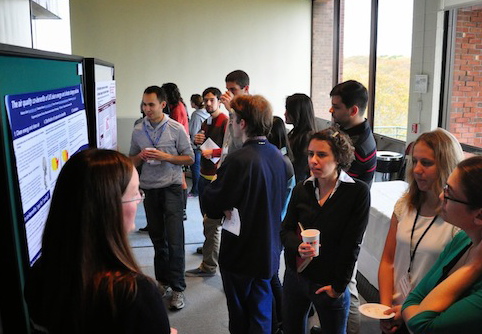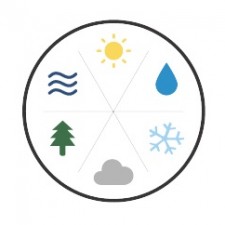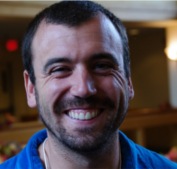Featured Stories | November 24, 2013
“Let’s Just Do Science:” The Origins of the Graduate Climate Conference
By Genevieve Wanucha
Sixteen graduate students in MIT’s Program in Atmospheres, Oceans, and Climate (PAOC) have settled back to work after organizing and leading the 7th Graduate Climate Conference (GCC), which took place at Woods Hole Oceanographic Institution earlier in November. Entirely student-run, without a hint of faculty involvement, the international conference provides a forum for graduate students who study climate in a variety of disciplines such as atmospheric chemistry and earth and ocean sciences. The 105 attending graduate students from 36 different institutions–the biggest GCC yet–emerged from the busy weekend with a sense of how their work interfaces with other areas of the climate system.

“It’s a different flavor of education than you’d get at an American Geophysical Union or American Meteorological Society conference,” says Daniel Rothenberg who co-chaired this year’s conference along with Sarah Rosengard. “You get to learn science in a non-pressured environment where you don’t have to worry about being eviscerated by an expert who has been doing it for 40 years, or someone stealing your idea because it’s super-competitive.”
This quality of rebellious, self-aware leadership is written into the DNA of this student-run endeavor. In fact, the idea for the GCC was born in a moment of frustration at the status quo of climate conferences.
It happened at a 2006 summer institute on El Niño-Southern Oscillation (ENSO) run by the University of Washington (UW). Although the conference was meant specifically for students, the organizers had brought in many experts. Two slides into one researcher’s overview, which was meant to place the science into a framework that the students could comprehend, another researcher interrupted, steering the conversation into nuances. “That basically lost 90% of the group right away,” says Aaron Donohoe, then a first-year graduate student at UW, now a postdoc and atmospheric dynamicist in MIT’s PAOC. “The rest of the sessions continued like that–experts talking to experts about things only they understand.”
The hampered learning opportunity sparked an idea amongst several first-year UW graduate students during a productive car ride home from the ENSO conference. The group included David Nicholson who is now a marine chemist at WHOI; Shelley Kunasek, now an earth and space scientist who teaches science in the Seattle area; and Carrie Lee, now a staff scientist at the Seattle Office of the Stockholm Environment Institute. There was no reason why they couldn’t take the initiative and build a conference where graduates students could actually engage with science on their own terms. Donohoe soon jumped aboard the plan for the first Graduate Climate Conference.
The determined group began piecing together $500 to $2,000 donations from different departments at UW, gaining the most support from UW’s Program on Climate Change. That got the first conference’s logistics up and running. Now, the GCC has support from MIT’s Henry Houghton Fund and the National Science Foundation, among other sources. Since 2011, the GCC has rotated between MIT and UW, the two institutions with the strong graduate student leadership in climate science needed to sustain the annual effort.
The conference’s original blueprint looked a lot like the GCC of today. About nine sessions are organized around different realms of climate science, such as paleoclimate, ocean biology, or terrestrial ecosystems, in which several graduate students present their work. At the start of each one, a session chair communicates how the upcoming talks relate to the bigger picture. For example, Alec Bogdanoff of the MIT-WHOI Joint Program, who co-chaired the ‘Ocean Dynamics’ session at the 2013 GCC along with Isabela Le Bras, prefaced the graduate students’ presentations by speaking about how the ocean plays a key role in the climate system at many scales, for example, by the helping transport heat to the poles and influencing storm tracks.

The GCC is tailored to the strengths and needs of young scientists. “I think a lot of what graduate students get trained to do is look closely at a very specific problem,” says Donohoe, “whereas this conference aims to take a step back and view the problem in context of how it’s relevant to all disciplines of climate science. That involves distilling information into manageable pieces–and graduate students are awesome at that.”
As intended by its creators, the GCC serves as a network of graduate students. “A majority of these students will go on to become researchers in this field or something very closely related,” says Rothenberg, “so having these connections is good for building interdisciplinary teams for projects in future. It also promulgates ideas into the community and preserves them.” Ask any GCC alum, and he or she will tell you that when they run up against a hard science problem, one of the first people they call is someone they met at a past conference.
The GCC has stuck fast to its roots, but there are signs of evolution. The original conference did not include climate change policy or social studies. But that’s slowly changed. This year, PAOC’s Rebecca Saari brought policy into the conversation with the poster The US market for cool, clear skies: exploring key drivers of air quality impacts under climate change policy. And, the largest crowds gathered in the session called “Humans, Climate, and Policy,” which featured research on views in tribal cultures on climate change, fisheries economics, and analyses of mass media representations of climate change certainty. This inclusion of policy isn’t quite Donohoe’s vision. For him, “just doing science” that builds a foundational understanding of Earth’s climate system is crucial at a time when the emphasis in the field at large has shifted markedly towards climate change. It’s as simple as the fact that the next generation of climate scientists lives in a world where questions about how to deal with the impact of global warming on society are increasingly hard to avoid, in academia and beyond. It’s their prerogative to find a place within it.







